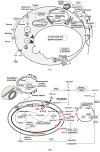Intermittent Cold Exposure Induces Distinct Proteomic Signatures in White Adipose Tissue of Mice
- PMID: 40869217
- PMCID: PMC12386456
- DOI: 10.3390/ijms26167898
Intermittent Cold Exposure Induces Distinct Proteomic Signatures in White Adipose Tissue of Mice
Abstract
Adipose tissue exhibits dynamic metabolic and structural changes in response to environmental stimuli, including temperature fluctuations. While continuous cold exposure has been extensively studied, the molecular effects of prolonged intermittent cold exposure (ICE) remain poorly characterized. Here, we present a proteomic analysis of inguinal white adipose tissue (IWAT) from mice subjected to a 16-week regimen of short-term daily ICE (6 °C for 6 h, 5 days per week) without compensatory caloric intake. Mass spectrometry identified 1108 proteins, with 140 differentially expressed between experimental and control groups. ICE significantly upregulated mitochondrial proteins associated with lipid and carbohydrate catabolism, the tricarboxylic acid (TCA) cycle, oxidative phosphorylation, and lipogenesis, including LETM1, AIFM1, PHB, PHB2, ACOT2, NDUA9, and ATP5J. These changes reflect enhanced metabolic activity and mitochondrial remodeling. In contrast, proteins linked to oxidative stress, insulin resistance, inflammation, and extracellular matrix remodeling were downregulated, such as HMGB1, FETUA, SERPH1, RPN1, and AOC3. Notably, gamma-synuclein (SYUG), which inhibits lipolysis, was undetectable in ICE-treated samples. Our findings support the hypothesis that ICE promotes thermogenic reprogramming and metabolic rejuvenation in subcutaneous fat through activation of futile cycles and mitochondrial restructuring. This study offers molecular insights into adaptive thermogenesis and presents intermittent cold exposure as a potential strategy to mitigate adipose tissue aging.
Keywords: adipose tissue; futile cycles; intermittent cold exposure; mitochondrial remodeling; proteomics; thermogenesis.
Conflict of interest statement
The authors declare no conflicts of interest.
Figures





References
-
- Sárvári A.K., Van Hauwaert E.L., Markussen L.K., Gammelmark E., Marcher A.-B., Ebbesen M.F., Nielsen R., Brewer J.R., Madsen J.G.S., Mandrup S. Plasticity of Epididymal Adipose Tissue in Response to Diet-Induced Obesity at Single-Nucleus Resolution. Cell Metab. 2021;33:437–453.e5. doi: 10.1016/j.cmet.2020.12.004. - DOI - PubMed
MeSH terms
Substances
LinkOut - more resources
Full Text Sources
Research Materials
Miscellaneous

